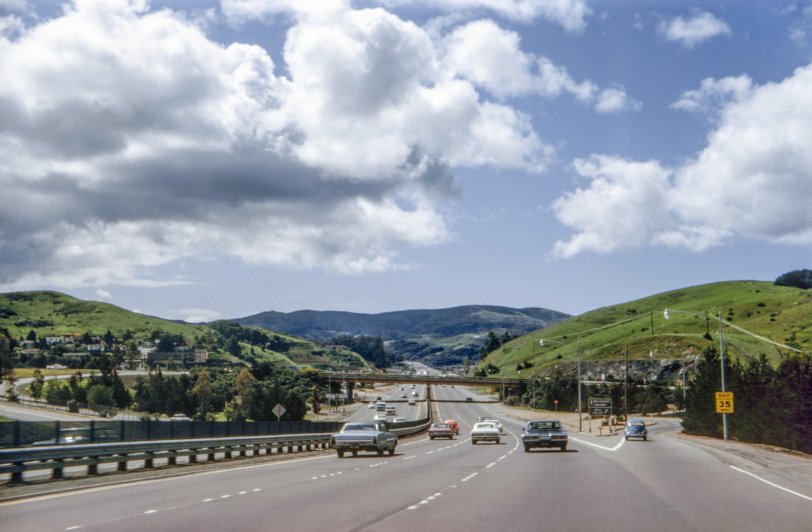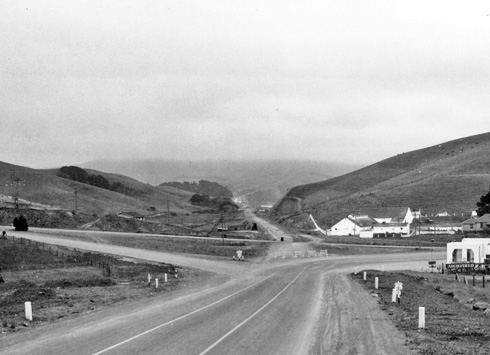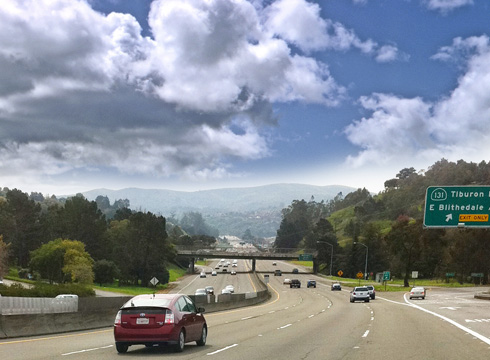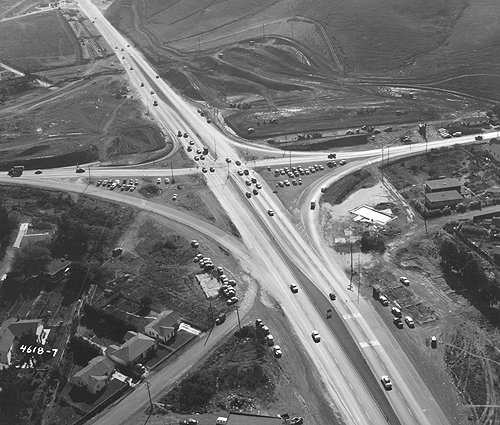


Framed or unframed, desk size to sofa size, printed by us in Arizona and Alabama since 2007. Explore now.
Shorpy is funded by you. Patreon contributors get an ad-free experience.
Learn more.

- Baldwin 62303
- Baldwin VO-1000
- Cold
- No expense spared
- Tough Guys
- Lost in Toyland
- And without gloves
- If I were a blindfolded time traveler
- Smoke Consumer Also Cooks
- Oh that stove!
- Possibly still there?
- What?!?
- $100 Reward
- Freeze Frame
- Texas Flyer wanted
- Just a Year Too Soon
- WWII -- Replacing men with women at the railroad crossing.
- Yes, Icing
- You kids drive me nuts!
- NOT An Easy Job
- I wonder
- Just add window boxes
- Icing Platform?
- Indiana Harbor Belt abides
- Freezing haze
- Corrections (for those who care)
- C&NW at Nelson
- Fallen Flags
- A dangerous job made worse
- Water Stop
Print Emporium
The Dawn of Botts Dots: 1969

Three years after the first Botts dots were installed on a California highway, I took this Kodachrome going south on US 101 at the Alto interchange in Marin County, California. This was when it was still a full cloverleaf, with its hair-raisingly overlapping entry and exit lanes below the overpass. Off to the left, Belvedere and Tiburon; to the right, Mill Valley. Again, this is the era of Volkswagen Beetle ubiquity: there are at least three visible here, one in its favorite habitat, the fast lane. View full size.
1931 Pic
Here is a classic shot of almost the exact location of tterrace's 1969 picture. This is well before the Golden Gate Bridge was built. All traffic at Alto Wye had to turn right and travel through Mill Valley to continue on towards Sausalito and then San Francisco via ferry.
More detail:
http://content.cdlib.org/ark:/13030/kt1v19q6ff/

1930s
The Redwood Highway (southbound) swung hard right here and went west of the big hill on the right back in the 1930s. I think about the time the bridges were being built (BB and GGB, 1935-37) the highway cut was made through here and connected with the then-new Richardson Bay Bridge, itself made of redwood and replaced in the late '50s when the freeway was built.
Botts update.
I've been meaning to take this shot since seeing this image, but I just don't go in that direction as much as I used to. I had to use my iphone, as I forgot to bring my "real" camera. It gives an idea of how things have changed. The shot was taken well after the commute time, and seems not much different than the original shot. It was a gray day, so I decided to sample the original clouds to spruce things up. The Prius has replaced the Volkswagen in these parts as the people's car.

Tailgating
I drove a VW bug for 17 years and noticed an unfailing rule which is also evident in this picture: People always tailgate you when you drive a Volkswagen in the left (fast) lane, even if you're speeding yourself.
Rolling Hills
Thanks for another Marin Memory, tterrace. I navigated this turnoff daily when I lived in the Strawberry district of Mill Valley from 1969 to 1971.
I'm also very familiar with the surge in development described by other posters that has taken place here over the last four decades. Both sides of the freeway beyond the overpass are now crowded by shopping centers, car dealerships, and gas stations.
But there's also good news to report.
The reason the hills in the distance have escaped development is that they were set aside in 1972 as part of a sprawling urban park called the Golden Gate National Recreation Area. The area, now known as the Marin Headlands, is under stewardship of the National Park Service.
Sparse cars
I imagine it's been many a day since that road has been that lightly traveled.
Lou Judson
Hey, this was MY turnoff! I lived in Strawberry Point, over the hill on the left, from 1957 to 1971. All those hills except the top of the farthest one are now covered with houses! I nearly burst into tears when I came over the Alto hill and saw that they had chopped off the top of the hill on the right to build a development called Enchanted Knolls - with streets named after English poets (Yet I have never heard a poem as beautiful as a hill).
Personally I love cloverleaf interchanges. The skill it takes to negotiate them should be a driver test requirement! I feel they have been changed to stoplight intersections due to the stupidity of the common driver - and the offramp to the right now has four lanes and still backs up over the hill behind the pov.
At the time of this photo I was commuting to SF State College in my 58 VW bus from Strawberry. Twenty years later I was coming over the top of the Alto Hill when the Loma Prieta earthquake happened. I did not feel it because I was in my fourth VW bus, but saw the transformers on all the power poles in this picture explode in blue-white light as the grid went down and left us in the dark for a few days.
So many memories!
re: Pre-Botts
Wow, Steve Stephens, nifty! That's when it was called the Alto Wye, which I hazily remember along with the Corte Madera Wye just to the north. The days when four-lane divided roads like this were called superhighways.
Reflector dots
Here in the non-snowy parts of California, the reflectors placed between the groups of Botts dots are also raised. Even those become less and less reflective as they become scuffed, abraded, dirtied and chipped. A glass-beaded surface on the Botts dots would lose its reflectivity pretty quickly.
Pre-Botts Dots days
A circa 1955 photo, also looking south at the same spot, when the cloverleaf interchange in the main photo was in the process of being built to handle ever increasing Marin County traffic. I moved here in Sept. 1957 to start high school and can attest there have been a lot of changes here since then, and not for the better.

Reflections on a dot
To this day most Botts dots are non-reflective, so they don't show a whole lot better at night than painted lines. You can see a standard recessed (and snow plow friendly) reflector in the space between every other grouping of Botts dots in the picture. There are some technologies that give them reflectivity, but I'm surprised that they haven't standardized a technique that embeds glass beads into the surface for good reflectivity like with most road paint or thermoplastic striping.
Am I the only one who keeps mistyping it as Botts dotts?
Before Better Botts
The first generation of Botts Dots, I learned, were nailed to the pavement. After working free, they'd puncture tires. Later they were glued to the roadbed.
Neat idea
This first time I every saw those dots in 1974 I was astounded. I was visiting my grandmother in San Francisco and we were driving late at night. On the highway I saw an amazing sight, you could see all the lanes marked out with these green glowing dots just as well as if you were driving during the day. Right away, I wondered why didn't somebody think to do that back home. Why even in thick fog you would be able to see and stay in your lane without any trouble. If was obvious. Then somebody pointed out to me that with, back home in Canada, winter storms dropping a foot of snow on the highway and then snow plows scraping everything off the roads after they might not work quite as well as in California. Back to the drawing board and you know what? Almost 40 years later, they still haven't put any on the highways here! Go figure.
[Here in the Northeastern U.S., they embed the reflectors in the pavement so that they're flush with the surface and can't be scraped off by plows. - Dave]
Rule(s) of the Beetle
One of which was "the brighter the color, the more obnoxious the driver," which we see illustrated here. Is that a Fiat just behind it? It's hard to tell, but I think that's another VW in the northbound slow lane, just under the overpass from our point of view.
Otherwise a nice selection of Detroit iron: a Thunderbird, a Cougar, and a couple of Oldsmobiles in the southbound lane, plus something I can't make out. Northbound, another Beetle, a Dodge truck that may be an armored car, GMC pickup, and what looks like a '70 Ford but is probably a '69 unless this was quite late in the year, plus several others obscured by guardrail, other vehicles, or distance.
And you can actually see the pavement, instead of wall-to-wall sheet metal, in the daytime! Those were the days.
Ahh, Caluhfourneyeaye
What a gorgeous looking day. Photoshop out the highways, cars, roads, bridges, people, stoplights, and signs, and you have an Ansel Adams photograph.
























On Shorpy:
Today’s Top 5